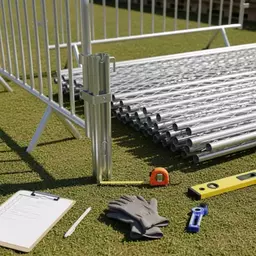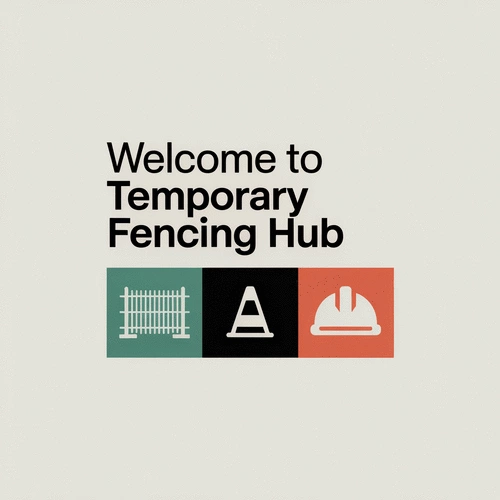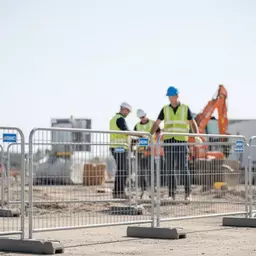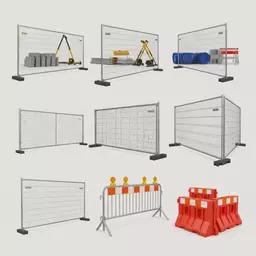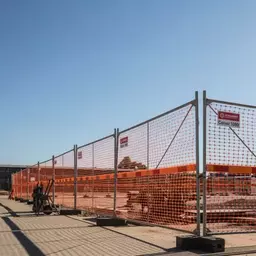When setting up temporary fencing, the smallest detail can make a world of difference. Proper installation not only enhances safety but also ensures compliance with regulations. Imagine attending an event where the fencing is secure and well-organized, guiding you effortlessly through the space. The right setup truly transforms the experience!
What You Will Learn
- The importance of proper temporary fencing setup for enhancing safety and compliance.
- Key applications of temporary fencing, including construction, events, and security measures.
- Essential safety regulations to consider when planning your fencing setup.
- A comprehensive pre-installation checklist to ensure effective site preparation.
- Step-by-step guide to executing a successful temporary fencing installation.
Temporary Fencing Setup: A Step-by-Step Guide
This visual outlines the crucial steps for preparing your site and installing temporary fencing effectively, ensuring safety and compliance. For a deeper dive into ensuring your fencing meets all necessary regulations, explore the Australian Temporary Fencing Safety Standards.
1. Pre-Installation Checklist
Step 1: Site Clearance
Remove obstacles and debris to ensure a smooth and safe installation area.
Step 2: Legal Compliance
Understand and secure necessary permits and adhere to local laws.
Step 3: Site Accessibility
Ensure easy access for equipment and materials to streamline installation.
Step 4: Ground Assessment
Evaluate ground conditions for preparation needs, like leveling or drainage.
2. Installation Execution
Step 5: Secure Panels
Use clamps or ties for stability, especially in outdoor conditions.
Step 6: Choose Anchors
Select appropriate anchors (concrete, spikes, sandbags) based on site conditions.
Step 7: Environmental Factors
Adapt setup to weather conditions (wind, rain) by reinforcing as needed.
Step 8: Fence Types
Understand chain-link, mesh, or solid barriers for different applications.
Step 9: Stake Placement
Properly position and drive stakes deep for a stable fence framework.
Understanding Temporary Fencing: Why Proper Setup Matters
When it comes to temporary fencing, the setup is crucial! The right installation can enhance safety, improve compliance with regulations, and provide peace of mind during events or construction projects. I often find that a well-planned fencing solution not only protects assets but also creates a clear boundary that guides the flow of people and traffic.
At Temporary Fencing Hub, I’ve seen firsthand how the effectiveness of temporary fencing can vary based on its application. Whether it’s for a bustling festival or a quiet construction site, understanding the specific needs of your scenario is essential.
Importance of Temporary Fencing in Various Scenarios
Temporary fencing serves a multitude of purposes across different contexts. It's not just about enclosing an area; it's about creating a safe and organized environment. Here are some of the key reasons why proper setup matters:
- Enhances safety by keeping unauthorized individuals out of hazardous areas.
- Facilitates crowd control during events, guiding attendees effectively.
- Protects valuable equipment and materials at construction sites.
- Ensures compliance with local regulations and safety standards.
In my experience, the importance of proper setup cannot be overstated. Without it, even the best fencing solution may fall short of expectations!
Common Applications: Construction, Events, and Security
Let’s explore some common applications of temporary fencing and how they seamlessly fit into different scenarios:
- Construction Sites: Provides safety barriers around machinery and materials, ensuring that only authorized personnel have access.
- Outdoor Events: Used for crowd control and demarcating areas for vendor stalls, stages, and emergency exits.
- Security Measures: Acts as a deterrent against theft and vandalism, securing valuables in temporary storage facilities.
Every application has unique requirements, and tailoring the fencing setup accordingly is key to achieving the desired outcomes! For detailed guidelines on how to set up fences for various events, check out our guide on Guidelines for Event Fencing Setup.
Key Safety Regulations to Consider When Setting Up Temporary Fencing
Safety regulations vary by location and type of event or project, so it’s essential to stay informed. Here are some regulations to keep in mind:
- Verify compliance with local council regulations regarding height and materials used.
- Check for required permits specific to your project or event type.
- Use barriers that comply with Australian safety standards for construction sites.
By adhering to these regulations, you’ll not only enhance safety but also avoid potential fines or delays in your project. Always double-check with local authorities for the most accurate information!
Preparing Your Site for Temporary Fencing Installation
Before diving into installation, taking the time to prepare your site can make a significant difference. A well-prepared area helps streamline the installation process and ensures that your fencing stands firm and secure.
Pro Tip
Did you know? Properly marking your fencing setup with clear signage can significantly enhance safety and compliance. Utilize visible signs to indicate restricted areas, emergency exits, and safety instructions. This not only helps in guiding attendees but also reinforces the importance of following safety protocols during events or construction activities.
Preparing Your Site for Temporary Fencing Installation
Getting your site ready for temporary fencing installation is crucial for ensuring safety and compliance. It might seem like a daunting task, but trust me, having a solid preparation plan can save you time and headaches down the road. Let's dive into the essential steps you need to take before the installation begins!
Essential Pre-Installation Checklist for Temporary Fencing
Before you start setting up temporary fencing, you need to check off a few critical items from your list. This will help create a smooth installation process and ensure everything is up to standard. Here’s what you should consider:
- Site clearance: Make sure to remove any obstacles and debris.
- Legal compliance: Understand the necessary permits and local laws.
- Assess site accessibility: Ensure equipment and materials can be easily accessed.
- Conduct a site assessment: Evaluate ground preparation needs.
By addressing these points, you’ll set a solid foundation for your temporary fence setup, making the subsequent installation steps much easier.
Site Clearance: Removing Obstacles and Debris
First things first—clearing your site is essential. Make sure to remove any debris, rocks, or materials that could interfere with the installation process. A clean site not only expedites the setup but also minimizes risks during the event or construction period. Remember, safety starts with a tidy workspace!
Legal Compliance: Understanding Permits and Local Laws
Next, you’ll need to dive into the legal aspects. Each location may have specific regulations regarding temporary fencing. It’s crucial to check with local authorities to understand what permits might be required. This step is vital to avoid potential fines and ensure your project remains compliant with safety standards.
Assessing Site Accessibility for Equipment and Materials
Site accessibility plays a significant role in how smoothly your installation goes. Ensure that your equipment and materials can reach the installation site without any issues. This includes checking for clear paths and adequate space for maneuvering. An accessible site can save you valuable time and hassle during the setup process.
Conducting a Site Assessment: Evaluating Ground Preparation Needs
Lastly, conduct a thorough site assessment to evaluate the ground conditions. Different sites may require different preparations, such as leveling the ground or addressing drainage issues. By anticipating these needs, you can ensure your temporary fencing remains stable and effective throughout its use.
Executing the Installation of Temporary Fencing
With your site prepared, it’s time to move on to the installation phase! This is where your planning pays off, and you can see your temporary fencing come to life. Let’s go through a step-by-step guide to make sure everything goes off without a hitch.
Step-by-Step Guide to Installing Temporary Fencing
Installing temporary fencing doesn’t have to be overwhelming. Follow these critical steps to ensure a successful setup:
- Secure panels: Use techniques for stability and safety.
- Choose the right anchors: Understand different types and their applications.
- Consider environmental factors: Adapt your setup to weather conditions.
- Understand different fence types: Know which suits your specific needs.
- Follow proper setup procedures: Pay attention to stake placement and installation techniques.
By breaking down the installation process into manageable steps, you can approach each phase with confidence. Let’s explore these steps in more detail!
Securing Panels: Techniques for Stability and Safety
When securing panels, it’s important to ensure they are stable to withstand outdoor conditions. Use appropriate fastening methods, like clamps or ties, to secure the panels together. Remember, a well-secured fence helps maintain safety and provides the necessary crowd control. For additional stability tips, particularly in adverse weather, refer to our guide on Securing Temporary Fencing in Winds.
Choosing the Right Anchors: Types and Their Applications
Not all anchors are created equal! Selecting the right type of anchor is essential for the effectiveness of your temporary fencing. Depending on your site conditions, you may choose from:
- Concrete blocks for added weight.
- Spikes for soft ground.
- Sandbags for versatile applications.
Each option has its advantages depending on your specific needs, so choose wisely!
Environmental Considerations: Adapting to Weather Conditions
Always consider the weather when installing temporary fencing. Strong winds or heavy rains can impact the stability of your setup. Make adjustments as necessary, such as adding additional anchors or reinforcing panels, to ensure your fencing can withstand the elements.
Understanding Different Fence Types and Their Applications
As you install your fencing, it's crucial to understand which type of fence fits your needs best. Options include:
- Chain-link fencing for visibility and strength.
- Mesh fencing for lightweight, temporary solutions.
- Solid barriers for privacy and security.
Choosing the right type of fence can enhance safety while providing the functionality you need.
Setup Procedures: Stake Placement and Installation Techniques
Finally, pay close attention to stake placement during installation. Properly positioned stakes will help create a stable framework for your fence. Install them in a straight line, making sure they are driven deep enough to provide adequate support. Following these procedures will ensure your temporary fence stands strong throughout its use.
Frequently Asked Questions (FAQs) about Temporary Fencing Setup
- Q1: Why is proper temporary fencing setup so important?
- A1: Proper setup is crucial for enhancing safety, ensuring compliance with local regulations, and effectively managing crowd control or site security. It prevents accidents and protects assets.
- Q2: What are the common applications for temporary fencing?
- A2: Temporary fencing is commonly used for construction sites to secure hazardous areas, at outdoor events for crowd control and demarcation, and for general security measures to deter theft and vandalism.
- Q3: What safety regulations should I be aware of?
- A3: You should check local council regulations for height and material specifications, obtain necessary permits for your specific project or event, and ensure your barriers comply with relevant safety standards, such as Australian safety standards for construction sites.
- Q4: What should be included in a pre-installation checklist?
- A4: A pre-installation checklist should include site clearance (removing obstacles), legal compliance (permits, local laws), site accessibility assessment (for equipment and materials), and a ground assessment (for leveling or drainage needs).
- Q5: How do I ensure the stability of temporary fence panels?
- A5: To ensure stability, use appropriate fastening methods like clamps or ties to secure panels together. Additionally, choose the right anchors (concrete blocks, spikes, sandbags) based on site conditions and adapt your setup to environmental factors like wind and rain by reinforcing as needed.
Recap of Key Points
Here is a quick recap of the important points discussed in the article:
- Proper setup of temporary fencing enhances safety and compliance with regulations.
- Temporary fencing serves various applications, including construction sites, outdoor events, and security measures.
- Adhering to local safety regulations and obtaining necessary permits is crucial for successful installations.
- Preparing the site by clearing obstacles and assessing accessibility is vital for effective fencing installation.
- Following a step-by-step guide during installation ensures stability and safety of the temporary fencing.


